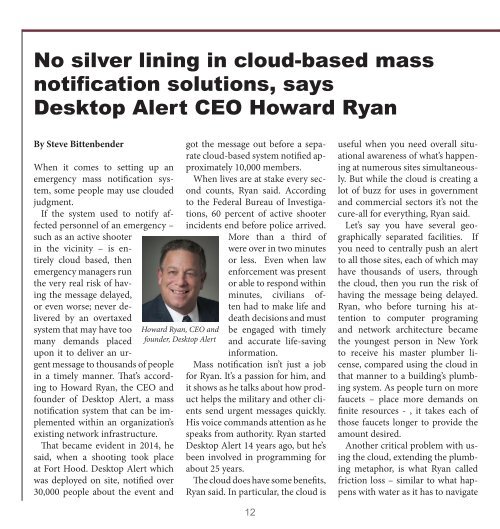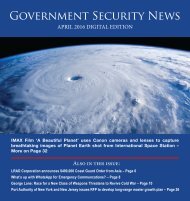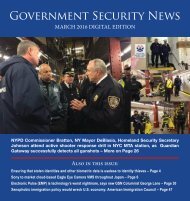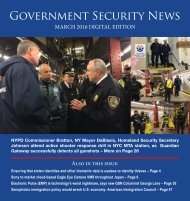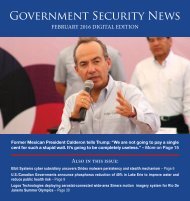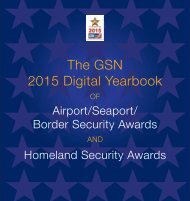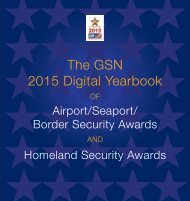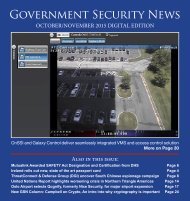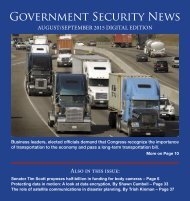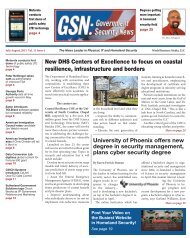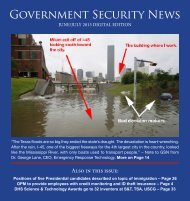GSN January 2016 Digital Edition
Create successful ePaper yourself
Turn your PDF publications into a flip-book with our unique Google optimized e-Paper software.
No silver lining in cloud-based mass<br />
notification solutions, says<br />
Desktop Alert CEO Howard Ryan<br />
By Steve Bittenbender<br />
When it comes to setting up an<br />
emergency mass notification system,<br />
some people may use clouded<br />
judgment.<br />
If the system used to notify affected<br />
personnel of an emergency –<br />
such as an active shooter<br />
in the vicinity – is entirely<br />
cloud based, then<br />
emergency managers run<br />
the very real risk of having<br />
the message delayed,<br />
or even worse; never delivered<br />
by an overtaxed<br />
system that may have too<br />
many demands placed<br />
upon it to deliver an urgent<br />
message to thousands of people<br />
in a timely manner. That’s according<br />
to Howard Ryan, the CEO and<br />
founder of Desktop Alert, a mass<br />
notification system that can be implemented<br />
within an organization’s<br />
existing network infrastructure.<br />
That became evident in 2014, he<br />
said, when a shooting took place<br />
at Fort Hood. Desktop Alert which<br />
was deployed on site, notified over<br />
30,000 people about the event and<br />
Howard Ryan, CEO and<br />
founder, Desktop Alert<br />
got the message out before a separate<br />
cloud-based system notified approximately<br />
10,000 members.<br />
When lives are at stake every second<br />
counts, Ryan said. According<br />
to the Federal Bureau of Investigations,<br />
60 percent of active shooter<br />
incidents end before police arrived.<br />
More than a third of<br />
were over in two minutes<br />
or less. Even when law<br />
enforcement was present<br />
or able to respond within<br />
minutes, civilians often<br />
had to make life and<br />
death decisions and must<br />
be engaged with timely<br />
and accurate life-saving<br />
information.<br />
Mass notification isn’t just a job<br />
for Ryan. It’s a passion for him, and<br />
it shows as he talks about how product<br />
helps the military and other clients<br />
send urgent messages quickly.<br />
His voice commands attention as he<br />
speaks from authority. Ryan started<br />
Desktop Alert 14 years ago, but he’s<br />
been involved in programming for<br />
about 25 years.<br />
The cloud does have some benefits,<br />
Ryan said. In particular, the cloud is<br />
useful when you need overall situational<br />
awareness of what’s happening<br />
at numerous sites simultaneously.<br />
But while the cloud is creating a<br />
lot of buzz for uses in government<br />
and commercial sectors it’s not the<br />
cure-all for everything, Ryan said.<br />
Let’s say you have several geographically<br />
separated facilities. If<br />
you need to centrally push an alert<br />
to all those sites, each of which may<br />
have thousands of users, through<br />
the cloud, then you run the risk of<br />
having the message being delayed.<br />
Ryan, who before turning his attention<br />
to computer programing<br />
and network architecture became<br />
the youngest person in New York<br />
to receive his master plumber license,<br />
compared using the cloud in<br />
that manner to a building’s plumbing<br />
system. As people turn on more<br />
faucets – place more demands on<br />
finite resources - , it takes each of<br />
those faucets longer to provide the<br />
amount desired.<br />
Another critical problem with using<br />
the cloud, extending the plumbing<br />
metaphor, is what Ryan called<br />
friction loss – similar to what happens<br />
with water as it has to navigate<br />
12


